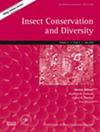Complex temporal trends in biomass and abundance of Diptera communities driven by the impact of agricultural intensity
IF 3.2
2区 农林科学
Q1 ENTOMOLOGY
引用次数: 0
Abstract


农业强度影响下双翅目群落生物量和丰度的复杂时间趋势
昆虫生物多样性和数量的减少已被广泛报道,预计将改变生态系统的功能和过程。土地利用的变化已被认为是造成这种下降的主要原因。然而,由于当地环境驱动因素和可用监测数据规模的差异,在哪些分类群正在减少、哪些地方减少最严重以及这些减少将如何影响生态系统等方面留下了巨大的知识空白。我们利用加拿大魁北克省南部约 10,000 平方公里范围内 40 个农场的 11 年(2006-2016 年)监测数据,量化了农业密度对双翅目(真蝇)数量和生物量的时间趋势的影响。我们发现,不同农场之间的时间趋势存在很大差异,这主要是由农业用地所造成的。与预期相反,在农业密度较高的地区,双翅目昆虫的数量随着时间的推移增加得更多,尤其是在谷类作物增加的情况下。与此相反,农业密集度较高地区的生物量下降幅度更大,不过这只是由于玉米和大豆产量增加,而非小麦等谷物产量增加。农场周围森林覆盖率的变化对趋势的影响最小。我们发现,随着农业密集覆盖率的增加,双翅目昆虫单位总数的生物量下降更快,这表明群落正在向个体生物量较低的小体型苍蝇转变。我们的研究结果表明,土地利用不仅会改变昆虫物种群的数量和物种组成,还会改变昆虫主要功能特征(如体型)的分布。
本文章由计算机程序翻译,如有差异,请以英文原文为准。
求助全文
约1分钟内获得全文
求助全文
来源期刊
CiteScore
7.70
自引率
8.60%
发文量
58
审稿时长
>12 weeks
期刊介绍:
To publish papers of the highest scientific quality within the general area of insect (and other arthropods) conservation and diversity covering topics ranging from ecological theory to practical management.
Papers are invited on the following topics: Conservation genetics; Extinction debt; Long-term conservation planning and implementation; Global implications of local or national conservation actions; Management responses of species and communities; Captive breeding programs; Comparisons of restored and natural habitats; Biogeography; Global biodiversity; Metapopulation dynamics; Climate change: impacts on distributions and range; Invasive species: impacts and control; Effects of pollution; Genetic threats to diversity by introgression; Effects of fragmentation on diversity and distribution; Impact of agricultural and forestry practices on biodiversity; Enhancing urban environments for diversity and protection; Biodiversity action plans: can we scale up from insects?; Effectiveness and choice of indicator species; Soil biodiversity and interactions with above-ground biodiversity; Ecological interactions at local levels; Ecological and evolutionary factors influencing diversity and local, regional and global scales; Sustainable livelihoods and training on the ground; Integrating science and policy.

 求助内容:
求助内容: 应助结果提醒方式:
应助结果提醒方式:


